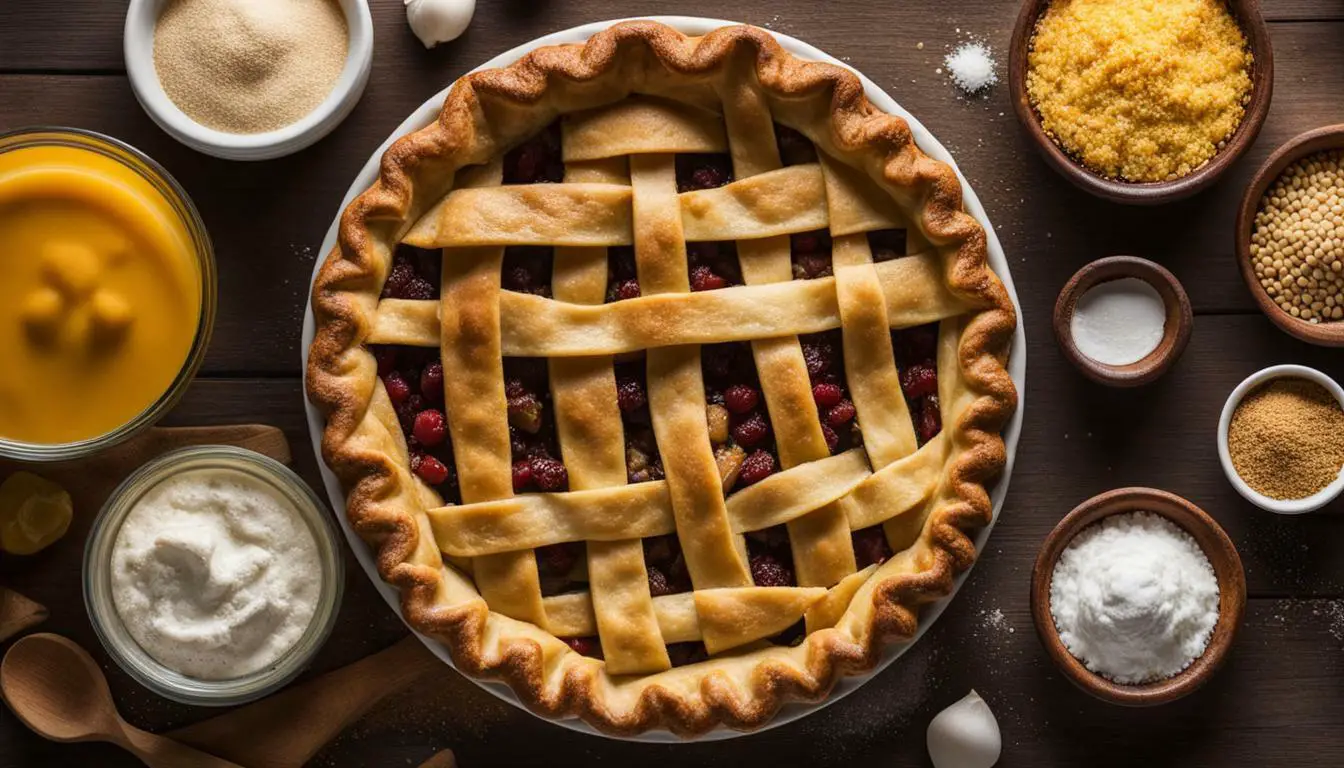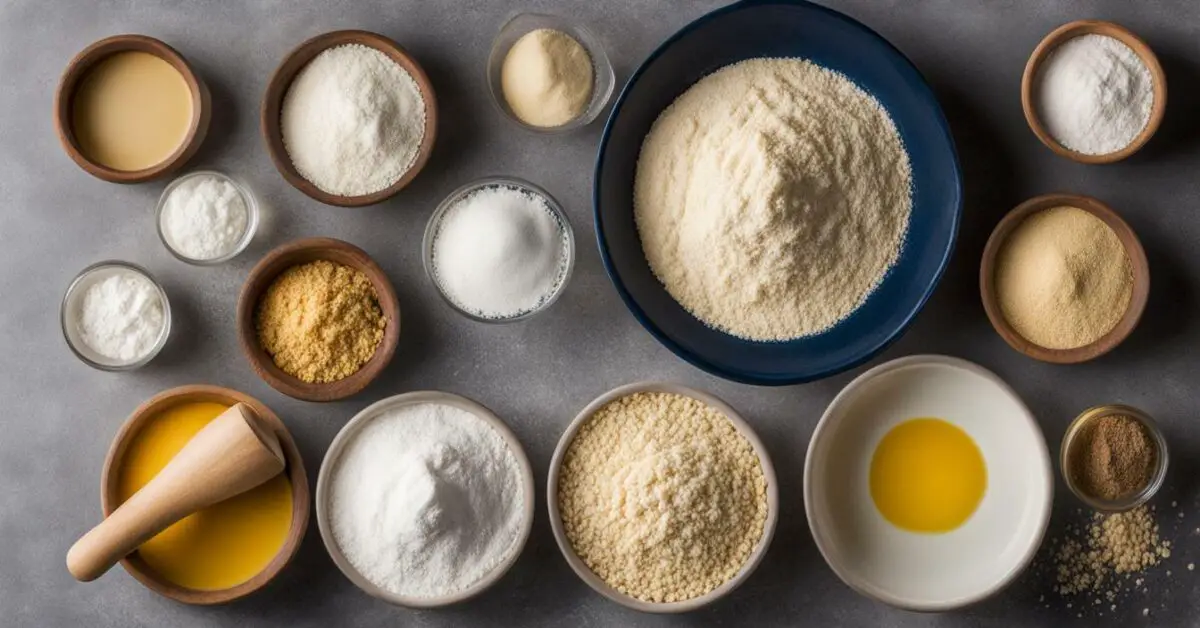
This post may contain affiliate links. Please read my disclosure for more information.
Are you looking for substitutes for cornstarch in your pie recipes? Discover the 7 best ways to achieve the same thickening power and texture without using cornstarch.
Key Takeaways:
- All-purpose flour can be used as a substitute for cornstarch in pie, but it may not provide the same glossiness.
- Tapioca starch is another alternative with a recommended ratio of 2 tablespoons for every 1 tablespoon of cornstarch.
- Rice flour works well in cookie recipes as a replacement for cornstarch.
- Potato starch is a good substitute for cornstarch in cake recipes.
- Arrowroot powder and tapioca starch can be used in soups, sauces, and gravies, but they may not hold thickness for a long time or reheat well.
When making a slurry, you can create a roux using all-purpose flour instead of cornstarch. Other substitutes such as arrowroot powder and tapioca starch may not provide as much thickness. Overall, there are several effective alternatives for cornstarch in pie-making.
All-Purpose Flour as a Substitute for Cornstarch in Pie
All-purpose flour is a commonly used alternative to cornstarch in pie recipes, although it may not provide the same glossy finish. This pantry staple is readily available and can be used in a 1:1 ratio as a substitute for cornstarch. However, it is important to note that the texture and consistency of the filling may be slightly different when using flour.
To use all-purpose flour as a substitute for cornstarch in pie, begin by whisking together the dry ingredients called for in the recipe, such as sugar, spices, and salt. Then, gradually add the flour to the mixture, ensuring it is well incorporated. Next, combine the flour mixture with the fruit or other filling ingredients, making sure to evenly coat everything. The flour will thicken the filling as it bakes.
While all-purpose flour is a viable substitute for cornstarch in pie, it is important to keep in mind that it may result in a slightly denser texture. Additionally, the filling may not have the same translucent appearance that cornstarch provides. However, if you do not have cornstarch on hand or prefer to avoid using it, all-purpose flour can still yield a delicious pie.
| All-Purpose Flour | Cornstarch |
|---|---|
| Common substitute | Standard thickening agent |
| 1:1 ratio | 1:1 ratio |
| Denser texture | Light and glossy appearance |
Summary:
- All-purpose flour can be used as a substitute for cornstarch in pie recipes.
- It should be used in a 1:1 ratio and whisked with other dry ingredients before adding to the filling.
- The resulting pie may have a slightly denser texture and lack the shiny appearance of cornstarch.
Tapioca Starch as a Substitute for Cornstarch in Pie
Tapioca starch can be used as a reliable substitute for cornstarch in pie, with a ratio of 2 tablespoons of flour or tapioca starch for every 1 tablespoon of cornstarch. This versatile ingredient is derived from the cassava plant and is known for its ability to thicken liquids and create a smooth texture.
When using tapioca starch as a substitute, it’s important to note that it may result in a slightly different texture compared to cornstarch. Tapioca starch tends to create a more gelatinous texture, which can be pleasing in certain pie fillings. It also has a neutral flavor, making it a suitable choice for various types of pies.
To use tapioca starch in your pie recipe, simply substitute it in equal quantities for the cornstarch called for. Start by mixing the tapioca starch with any sugar or other dry ingredients in your recipe before adding it to the filling. This helps to prevent clumping and ensures even distribution throughout the pie.
| Cornstarch | Tapioca Starch |
|---|---|
| 1 tablespoon | 2 tablespoons of flour or tapioca starch |
In conclusion, tapioca starch is a great alternative to cornstarch in pie-making. It provides the thickening power needed to create a delicious and well-set filling. Experiment with tapioca starch to find the perfect texture and consistency for your pies.
Rice Flour as a Substitute for Cornstarch in Pie
If you’re looking for a gluten-free alternative to cornstarch in your pie crusts or fillings, consider using rice flour. Rice flour is made from finely ground rice and has a light, powdery texture that works well as a thickening agent. It can provide a similar level of thickness to cornstarch and is ideal for those with gluten sensitivities or allergies.
When using rice flour as a substitute for cornstarch in your pie recipes, it’s important to keep in mind its slightly different properties. Rice flour doesn’t provide the same glossy finish as cornstarch, so your pie filling may not have the same sheen. However, it still creates a smooth and creamy consistency that will add body to your pies.
To replace cornstarch with rice flour, you will typically use a 1:1 ratio. For example, if your recipe calls for 1 tablespoon of cornstarch, you can substitute it with 1 tablespoon of rice flour. This ensures that you maintain the proper thickening power and texture in your pie filling.
To ensure the best results, it’s recommended to mix rice flour with a small amount of cold water or other liquid before adding it to your pie filling. This helps prevent clumping and allows the rice flour to evenly distribute throughout the mixture. It’s also a good idea to cook your pie filling for a few minutes longer to activate the thickening properties of the rice flour.
| Cornstarch | Rice Flour |
|---|---|
| Provides a glossy finish | No glossy finish |
| 1:1 ratio substitution | 1:1 ratio substitution |
| Smooth and creamy consistency | Smooth and creamy consistency |
| Clumping may occur without mixing with liquid beforehand | Mix with liquid before adding to the filling |
Overall, rice flour is a versatile substitute for cornstarch in pie-making, especially if you’re looking for a gluten-free option. It may not provide the same glossy finish, but it still adds thickness and body to your pie fillings. Experiment with different ratios and methods to find the perfect balance for your recipes.
Potato Starch as a Substitute for Cornstarch in Pie
Potato starch can be a great replacement for cornstarch in pie fillings, especially when it comes to creating moist and tender cakes. It is a versatile ingredient that adds thickness and texture to desserts without altering the flavor too much. When using potato starch as a substitute for cornstarch, it’s essential to understand the proper ratio to ensure successful results.
To substitute cornstarch with potato starch, use a 1:1 ratio. For example, if a recipe calls for 1 tablespoon of cornstarch, you can replace it with 1 tablespoon of potato starch. The starch helps absorb excess liquid and creates a smooth consistency in the filling. Plus, potato starch provides a light and airy texture, making your pie fillings irresistibly delicious.
When using potato starch in pie recipes, it’s important to note that it thickens faster than cornstarch. Therefore, it’s recommended to stir the starch into the liquid mixture gradually. This will prevent any lumps from forming and ensure a consistent texture. Additionally, remember to allow enough time for the pie to cool down and set properly to fully enjoy the benefits of potato starch as a substitute for cornstarch.
So, the next time you find yourself out of cornstarch, don’t worry! Potato starch is an excellent alternative that will provide the desired thickness and consistency in your pie fillings. With its ability to create moist and tender cakes, potato starch is sure to elevate your baking game and impress your family and friends.
| Potato Starch as a Substitute for Cornstarch in Pie | Cornstarch | Potato Starch |
|---|---|---|
| Thickness | Similar | Similar |
| Texture | Glossy | Light and airy |
| Ratio | 1:1 | 1:1 |
| Usage | Pie fillings, cakes | Pie fillings, cakes |
| Method | Stir gradually into liquid mixture | Stir gradually into liquid mixture |
Arrowroot Powder and Tapioca Starch as Substitutes for Cornstarch in Sauces and Gravies
When it comes to thickening sauces and gravies in your pie recipes, arrowroot powder and tapioca starch can step in as substitutes for cornstarch. These alternatives offer similar thickening properties to cornstarch and can be used in equal ratios in most recipes. However, it is important to note that there are some drawbacks to using arrowroot powder and tapioca starch as thickening agents.
One potential downside is that arrowroot powder and tapioca starch may not hold thickness for a long time or reheat well. This means that if you plan to make your pie ahead of time or reheat leftovers, the sauce or gravy may become thin or lose its thickness. It’s important to consider this when choosing a substitute for cornstarch in your pie recipes.
Despite these limitations, arrowroot powder and tapioca starch can still be effective alternatives for thickening sauces and gravies in your pies. They can provide a smooth texture and help achieve the desired consistency. Just keep in mind that if you need the sauce or gravy to stay thick for an extended period or if you plan to reheat the dish, you may need to explore other options or use additional thickening agents.
| Substitute | Ratio |
|---|---|
| Arrowroot Powder | 1 tablespoon for every 1 tablespoon of cornstarch |
| Tapioca Starch | 1 tablespoon for every 1 tablespoon of cornstarch |
Overall, arrowroot powder and tapioca starch can be viable options when substituting cornstarch in sauces and gravies for your pies. Just be mindful of their limitations and adjust your recipe accordingly if needed.
If you prefer a slurry method for thickening your pie fillings, you can make a roux using all-purpose flour instead of cornstarch. While all-purpose flour is a common substitute, it should be noted that it may not provide the same glossiness as cornstarch. However, it can still effectively thicken your pie filling and create a satisfying texture.
- To make a roux, start by melting butter in a saucepan over medium heat.
- Once the butter is melted, add all-purpose flour to the saucepan and whisk continuously until it forms a smooth paste.
- Continue to cook the roux for a few minutes, stirring constantly, to remove the raw flour taste.
- After the roux has cooked, gradually whisk in your desired liquid, such as milk or broth, until the mixture thickens.
- Once the desired consistency is reached, you can use the roux to thicken your pie filling, just as you would with cornstarch.
Using a roux made with all-purpose flour can be a versatile and effective alternative to cornstarch in pie recipes. It is important to note that the ratio of flour to liquid may vary depending on the recipe and desired thickness. Experimentation and adjustments may be necessary to achieve the desired results.
Overall, there are several effective substitutes for cornstarch in pie-making. Whether you choose all-purpose flour, tapioca starch, rice flour, potato starch, or even a roux, you can still create delicious pies with the desired consistency and texture. So don’t let the absence of cornstarch hold you back from enjoying homemade pies – get creative and experiment with these alternatives to find your perfect substitute!
Conclusion
Whether you’re looking to make gluten-free pies or simply ran out of cornstarch, there are various substitutes available that can offer similar thickening power and texture for your pie recipes. When it comes to replacing cornstarch in pie, all-purpose flour is a popular option. However, it’s important to note that while all-purpose flour can thicken your pie filling, it may not provide the same glossy finish as cornstarch.
If you’re looking for a gluten-free alternative, tapioca starch is a great option. You can use a ratio of 2 tablespoons of flour or tapioca starch for every 1 tablespoon of cornstarch. Tapioca starch works well in pies and provides a similar thickening effect without altering the taste. It’s important to note that if you use too much tapioca starch, it can result in a slimy texture, so be sure to follow the recommended ratio.
If you’re making cookies and need a substitute for cornstarch, rice flour can be used effectively. Rice flour adds a nice crunch to your cookies and can be substituted in equal amounts for cornstarch. On the other hand, if you’re making a cake and need a substitute, potato starch is a good option. It can be used in the same ratio as cornstarch in your cake recipes, providing a similar texture and thickness.
When it comes to sauces, gravies, and soups, arrowroot powder and tapioca starch can be used as substitutes for cornstarch. However, it’s important to note that these alternatives may not hold thickness for a long time or reheat well. They can provide a similar thickening effect, but they may not retain their consistency over time. If you prefer a slurry method, you can create a roux with all-purpose flour instead of cornstarch.
In conclusion, there are several effective substitutes for cornstarch in pie-making. Whether you choose to use all-purpose flour, tapioca starch, rice flour, potato starch, arrowroot powder, or a slurry made with all-purpose flour, you can confidently make delicious pies without the worry of running out of cornstarch. Experiment with different substitutes to find the one that best suits your preferences and dietary needs.
FAQ
What are the best ways to substitute for cornstarch in pie?
There are several alternatives you can use to substitute for cornstarch in pie, including all-purpose flour, tapioca starch, rice flour, potato starch, arrowroot powder, and tapioca starch.
Can all-purpose flour be used as a substitute for cornstarch in pie?
Yes, all-purpose flour can be used as a substitute for cornstarch in pie. However, it won’t provide the same glossiness as cornstarch.
How can tapioca starch be used as a substitute for cornstarch in pie?
To use tapioca starch as a substitute for cornstarch in pie, you can use a ratio of 2 tablespoons of flour or tapioca starch for every 1 tablespoon of cornstarch.
Is rice flour a good substitute for cornstarch in pie?
Rice flour works well as a substitute for cornstarch in pie, especially in cookie recipes.
Can potato starch be used as a substitute for cornstarch in pie?
Yes, potato starch can be used as a substitute for cornstarch in pie, particularly in cake recipes.
Can arrowroot powder and tapioca starch be used in sauces and gravies as substitutes for cornstarch?
Yes, arrowroot powder and tapioca starch can be used as substitutes for cornstarch in sauces and gravies. However, they may not hold thickness for a long time or reheat well.
How can all-purpose flour be used to make a slurry as a substitute for cornstarch in pie?
When making a slurry, all-purpose flour can be used as a substitute for cornstarch. It can be used to make a roux.
What are some effective substitutes for cornstarch in pie?
Some effective substitutes for cornstarch in pie include all-purpose flour, tapioca starch, rice flour, potato starch, arrowroot powder, and tapioca starch.


